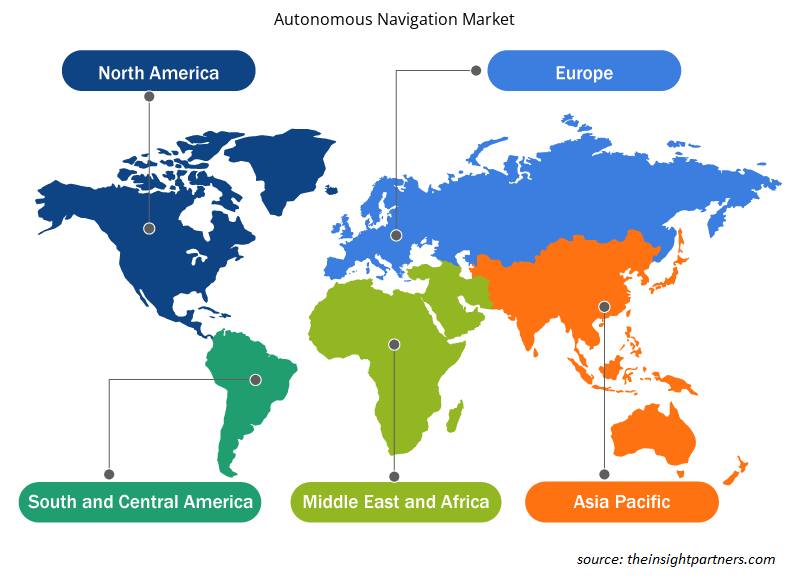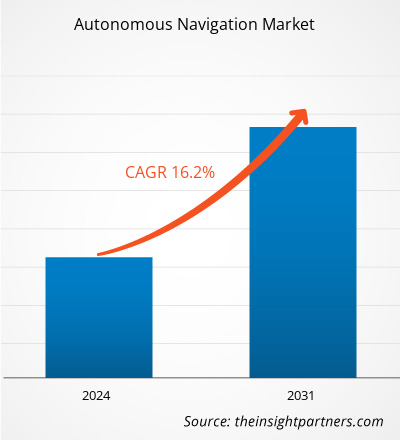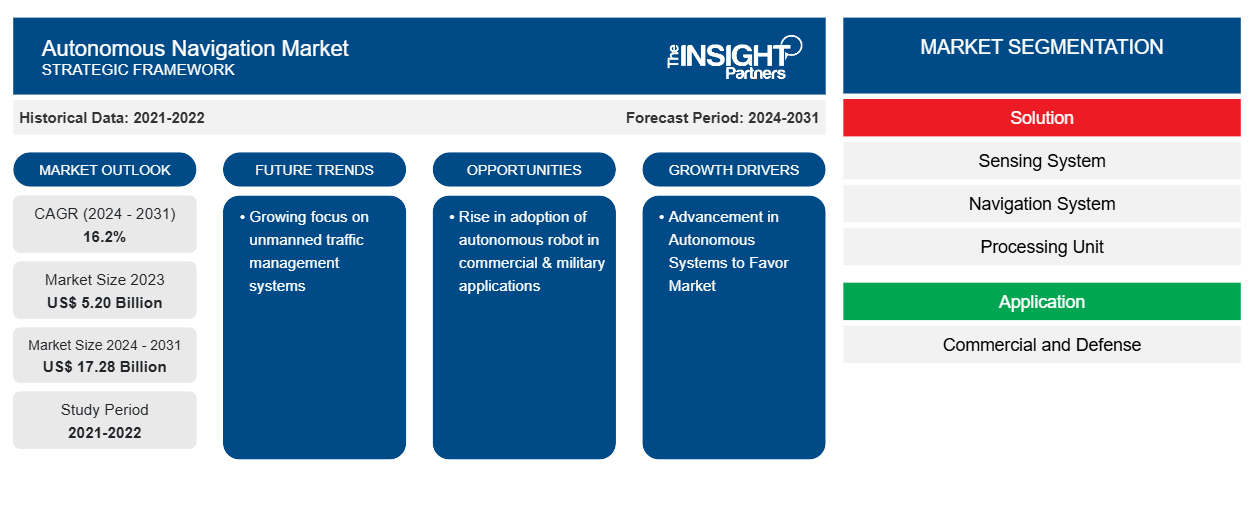Si prevede che le dimensioni del mercato globale della navigazione autonoma cresceranno da 5,20 miliardi di dollari nel 2023 a 17,28 miliardi di dollari entro il 2031; si prevede che si espanderà a un CAGR del 16,2% dal 2024 al 2031. È probabile che la crescente attenzione ai sistemi di gestione del traffico senza pilota rimanga una tendenza chiave del mercato della navigazione autonoma.
Analisi di mercato della navigazione autonoma
I tentativi in corso di far progredire i sistemi autonomi sono stati un fattore determinante nel settore della navigazione autonoma. Lo sviluppo di sistemi di navigazione autonomi avanzati per una varietà di piattaforme, tra cui aeree, terrestri, marine e spaziali, ha contribuito a guidare l'espansione del mercato.
Panoramica del mercato della navigazione autonoma
Un sistema di navigazione autonomo è una tecnologia complessa che consente a veicoli come droni, robot, automobili e barche di pianificare ed eseguire i propri itinerari senza la necessità di interazione umana. Questo sistema utilizza una combinazione di tecnologie complesse, tra cui navigazione inerziale, navigazione satellitare, radar, telecamere, navigazione ultrasonica e acustica , nonché potenti algoritmi, per formulare giudizi intelligenti in base all'ambiente circostante. Utilizzando queste tecnologie all'avanguardia, il sistema di navigazione autonomo garantisce che le auto navighino in modo preciso e sicuro.
Personalizza questo report in base alle tue esigenze
Riceverai la personalizzazione gratuita di qualsiasi report, comprese parti di questo report, o analisi a livello nazionale, pacchetto dati Excel, oltre a usufruire di grandi offerte e sconti per start-up e università
-
Scopri le principali tendenze di mercato in questo rapporto.Questo campione GRATUITO includerà analisi di dati che spaziano dalle tendenze di mercato alle stime e alle previsioni.
Driver e opportunità del mercato della navigazione autonoma
Avanzamento nei sistemi autonomi per favorire il mercato
I miglioramenti tecnologici e gli studi intensivi hanno contribuito in modo significativo all'evoluzione dei sistemi di navigazione autonomi. Questi miglioramenti hanno portato all'uso diffuso di veicoli autonomi, droni e sistemi robotici in una varietà di settori, tra cui trasporti, logistica, agricoltura e produzione. Le innovazioni tecnologiche in espansione nel settore della navigazione autonoma offrono varie prospettive per i produttori di auto autonome. La vicinanza ai grandi mercati automobilistici, come gli Stati Uniti, così come gli accordi commerciali come il North American Free Trade Agreement (NAFTA), contribuiscono a guidare l'espansione del settore della navigazione autonoma.
Aumento dell'adozione di robot autonomi in applicazioni commerciali e militari
L'accessibilità, il servizio più rapido e le qualità affidabili delle aziende basate su piattaforme di e-commerce hanno notevolmente accelerato l'espansione del settore dell'e-commerce . Questa espansione può essere attribuita a una serie di cause, tra cui innovazioni tecnologiche e ricerca e sviluppo in corso in robotica, visione artificiale, intelligenza artificiale ed edge computing. I robot autonomi svolgono un ruolo importante nelle applicazioni militari. Sono utilizzati in una varietà di attività di supporto al combattimento, tra cui guerra antisommergibile, posa mine, supporto di fuoco, guerra elettronica, gestione dei danni da battaglia, missioni di attacco, rifornimento aereo e altro ancora. Questi robot aiutano le forze militari in tutto il mondo sostituendo gli esploratori umani e svolgendo lavori che sono troppo rischiosi o difficili da completare per le persone.
Analisi della segmentazione del rapporto di mercato sulla navigazione autonoma
I segmenti chiave che hanno contribuito alla derivazione dell'analisi di mercato della navigazione autonoma sono la soluzione, l'applicazione, il tipo di veicolo e la piattaforma.
- In base alla soluzione, il mercato è suddiviso in sistema di rilevamento, sistema di navigazione, unità di elaborazione e software. Il segmento del sistema di rilevamento ha detenuto una quota di mercato maggiore nel 2023.
- In termini di applicazione, il mercato è diviso in commerciale e difesa. Il segmento commerciale ha detenuto una quota di mercato maggiore nel 2023.
- In base al tipo di veicolo, il mercato è suddiviso in AGV, robot mobili, UUV, droni e altri. Il segmento AGV ha detenuto una quota di mercato maggiore nel 2023.AGVs, Mobile Robots, UUVs, Drones, and Others. The AGVs segment held a larger market share in 2023.
- In base alla piattaforma, il mercato è diviso in terrestre, marino e spaziale. Il segmento terrestre ha detenuto una quota di mercato maggiore nel 2023.
Analisi della quota di mercato della navigazione autonoma per area geografica
L'ambito geografico del rapporto di mercato sulla navigazione autonoma è suddiviso principalmente in cinque regioni: Nord America, Asia Pacifico, Europa, Medio Oriente e Africa e Sud America/Sud e Centro America. Il Nord America ha dominato il mercato della navigazione autonoma nel 2023. Ciò è dovuto alla crescente domanda di trasporto automatizzato che è stato un motore significativo del mercato della navigazione autonoma in Nord America. Poiché le industrie e i consumatori cercano soluzioni di trasporto più efficienti e affidabili, la domanda di sistemi di navigazione autonomi è aumentata.
Approfondimenti regionali sul mercato della navigazione autonoma
Le tendenze regionali e i fattori che influenzano il mercato della navigazione autonoma durante il periodo di previsione sono stati ampiamente spiegati dagli analisti di Insight Partners. Questa sezione discute anche i segmenti e la geografia del mercato della navigazione autonoma in Nord America, Europa, Asia Pacifico, Medio Oriente e Africa e America meridionale e centrale.

- Ottieni i dati specifici regionali per il mercato della navigazione autonoma
Ambito del rapporto sul mercato della navigazione autonoma
| Attributo del report | Dettagli |
|---|---|
| Dimensioni del mercato nel 2023 | 5,20 miliardi di dollari USA |
| Dimensioni del mercato entro il 2031 | 17,28 miliardi di dollari USA |
| CAGR globale (2024 - 2031) | 16,2% |
| Dati storici | 2021-2022 |
| Periodo di previsione | 2024-2031 |
| Segmenti coperti |
Per soluzione
|
| Regioni e Paesi coperti |
America del Nord
|
| Leader di mercato e profili aziendali chiave |
|
Densità degli attori del mercato della navigazione autonoma: comprendere il suo impatto sulle dinamiche aziendali
Il mercato del mercato della navigazione autonoma sta crescendo rapidamente, spinto dalla crescente domanda degli utenti finali dovuta a fattori quali l'evoluzione delle preferenze dei consumatori, i progressi tecnologici e una maggiore consapevolezza dei vantaggi del prodotto. Con l'aumento della domanda, le aziende stanno ampliando le loro offerte, innovando per soddisfare le esigenze dei consumatori e capitalizzando sulle tendenze emergenti, il che alimenta ulteriormente la crescita del mercato.
La densità degli operatori di mercato si riferisce alla distribuzione di aziende o società che operano in un particolare mercato o settore. Indica quanti concorrenti (operatori di mercato) sono presenti in un dato spazio di mercato in relazione alle sue dimensioni o al valore di mercato totale.
Le principali aziende che operano nel mercato della navigazione autonoma sono:
- BlueBotics SA
- Azienda
- KONGSBERG
- Trimble Inc.
- Robot ASI
- Azienda aerospaziale Collins
Disclaimer : le aziende elencate sopra non sono classificate secondo un ordine particolare.

- Ottieni una panoramica dei principali attori del mercato della navigazione autonoma
Notizie e sviluppi recenti del mercato della navigazione autonoma
Il mercato della navigazione autonoma viene valutato raccogliendo dati qualitativi e quantitativi dopo la ricerca primaria e secondaria, che include importanti pubblicazioni aziendali, dati associativi e database. Di seguito è riportato un elenco degli sviluppi nel mercato:
- A giugno 2022, BlueBotics ha lanciato ANTdriven.com, una nuova risorsa educativa volta ad aiutare i professionisti ad iniziare il loro viaggio AGV (Automated Guided Vehicle). La piattaforma fornisce contenuti educativi chiari e utili e strumenti utili e offre persino una consulenza gratuita da parte di esperti. È progettata per aiutare i potenziali acquirenti a superare le sfide e a trovare i veicoli automatizzati più adatti alle loro attività. ANTdriven.com offre un'ampia gamma di contenuti adatti a ogni visitatore, indipendentemente da dove si trovi nel suo viaggio AGV.
(Fonte: BlueBotics, Comunicato stampa, 2022)
Copertura e risultati del rapporto sul mercato della navigazione autonoma
Il rapporto "Dimensioni e previsioni del mercato della navigazione autonoma (2021-2031)" fornisce un'analisi dettagliata del mercato che copre le seguenti aree:
- Dimensioni e previsioni del mercato a livello globale, regionale e nazionale per tutti i segmenti di mercato chiave coperti dall'ambito
- Dinamiche di mercato come fattori trainanti, vincoli e opportunità chiave
- Principali tendenze future
- Analisi dettagliata delle cinque forze PEST/Porter e SWOT
- Analisi di mercato globale e regionale che copre le principali tendenze di mercato, i principali attori, le normative e gli sviluppi recenti del mercato
- Analisi del panorama industriale e della concorrenza che copre la concentrazione del mercato, l'analisi della mappa di calore, i principali attori e gli sviluppi recenti
- Profili aziendali dettagliati
- Analisi storica (2 anni), anno base, previsione (7 anni) con CAGR
- Analisi PEST e SWOT
- Valore/volume delle dimensioni del mercato - Globale, Regionale, Nazionale
- Industria e panorama competitivo
- Set di dati Excel
Report recenti
Testimonianze
Motivo dell'acquisto
- Processo decisionale informato
- Comprensione delle dinamiche di mercato
- Analisi competitiva
- Analisi dei clienti
- Previsioni di mercato
- Mitigazione del rischio
- Pianificazione strategica
- Giustificazione degli investimenti
- Identificazione dei mercati emergenti
- Miglioramento delle strategie di marketing
- Aumento dell'efficienza operativa
- Allineamento alle tendenze normative























 Ottieni un campione gratuito per - Mercato della navigazione autonoma
Ottieni un campione gratuito per - Mercato della navigazione autonoma